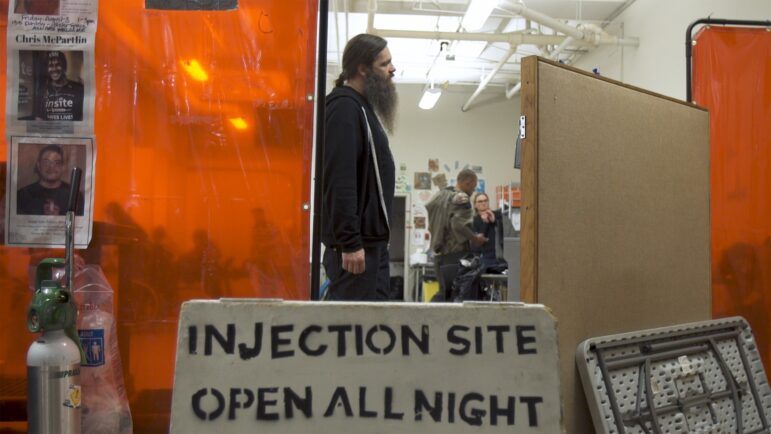Stations seek alternatives as ITVS plans to shut down OVEE platform

Courtesy Ruby Duncan
Alversa Beals celebrating the opening of Operation Life’s medical clinic in West Las Vegas in 1972 in "Storming Caesars Palace," a documentary being screened on OVEE this year.
The Independent Television Service will sunset its OVEE service, a platform used by filmmakers, educators and stations to livestream public media documentaries and connect with viewers virtually.
ITVS announced in a newsletter last month that it will deactivate the platform effective June 30. “After conducting an extensive market analysis and stakeholder interviews, we learned that new commercial options offer features and services that we cannot match at this time,” ITVS said. “This was not an easy decision, but we hope you understand why we decided to make this change.”
The organization said an analysis of OVEE’s usage “highlighted newer commercial platforms that come closer than they once did to OVEE’s user experience and offer 24/7 tech support and other services that ITVS is not equipped to provide.” ITVS added that it will now focus its “tech innovation resources” on DocScale, an interactive feedback platform.
ITVS, based in San Francisco, developed OVEE with financial support from CPB in 2010 and launched it in 2012. The service peaked at 15,000 monthly users during the pandemic and has been used to host more than 3,000 events since its creation, according to ITVS.
ITVS is not recommending a particular OVEE replacement to stations, “as our analysis revealed that most partners are now familiar with many other tools including Hopin, Maestro, and Vimeo Live to name a few,” it said in an FAQ.
Ending OVEE does not affect ITVS’ ongoing 2022–23 Indie Lens Pop-Up season, which concludes in May. The organization uses OVEE for the screenings. In the FAQ, ITVS said it is testing other virtual engagement platforms and plans to select a substitute by June, before the start of the 2023–24 Indie Lens Pop-Up season. It is taking suggestions from OVEE users on features they want the alternative service to have.
ITVS will offer trainings in March to help users transition from the service.
‘We love OVEE’
Maryland Public Television used OVEE to host at least two events each month in 2020 and 2021 when in-person screenings were canceled due to the COVID-19 pandemic, according to Kristen Penczek, MPT’s managing director of audience engagement.
“We joked both in MPT and with my colleagues across the country that OVEE saved our engagement with our viewers during that time,” Penczek said.
MPT didn’t use OVEE as frequently last year now that in-person meetings are starting to come back. But Penczek said “it was a gut punch” to hear that OVEE was going away.

“We love OVEE. We like what their functionally has to offer,” she said. Aside from the chat features, she liked that OVEE provided data on where users logged in from, how active they were in the chat, as well as other demographic and geographic information. She also liked that stations could easily join screenings hosted by other stations, which led to more collaborations.
Emmalee Hackshaw, VP of community engagement for Georgia Public Broadcasting, said her team collaborated with New Mexico PBS for a OVEE screening of a Finding Your Roots episode about genealogy in minority populations. GPB also partnered with KQED in San Francisco in May 2020 for a “Bob Ross Paint-Along.”
GPB has hosted 45 events using OVEE since 2016 with about 2,800 participants, Hackshaw said. Along with the platform’s metrics, she liked that OVEE’s website kept a schedule of upcoming screening events from around the country in a central location.
“I have been in the audience for screenings that I would not have known about if I hadn’t seen it on OVEE,” she said. “It’s a cool way for stations to share their original productions that someone outside of that market might not know about.”
Laurel Wyckoff, education and outreach manager for NMPBS, said OVEE was an especially important platform during the pandemic but noted that the service has its flaws.
“You could not do a panel discussion in OVEE,” Wyckoff said. “I had to have a Zoom panel discussion and then bridge it via YouTube into OVEE so that the audience wouldn’t have to move … and there was a 25-second delay, which made me crazy.”
Wyckoff said her station may exclusively use Zoom’s webinar function for future screenings, though she is curious about platforms like StreamYard, Eventbrite and Vimeo. She’s less enthusiastic about Hopin after seeing someone have trouble with the platform during a conference presentation.
Penczek said she wants the next platform MPT uses to have more features that make it easier to host live panel discussions. For the time being, MPT has used StreamYard in conjunction with OVEE to feature panelists. Operating both services at the same time on the back end wasn’t cumbersome, but Penczek said it would be nice to have a platform that could handle all of the station’s needs.
“One of the things that I like about OVEE is the simplicity of it. It does what we need it to do,” she said. “We don’t need a virtual online conference platform. It’s an interactive screening platform. … That’s the role it served for us, and that’s what we’re going to be looking for in a replacement.”






This is certainly a significant change for stations that rely on OVEE for their community engagement. I’m curious to see what alternatives will emerge and how they will impact the way we connect with audiences. It seems crucial for stations to find a sustainable solution that maintains the level of interactivity OVEE provided.